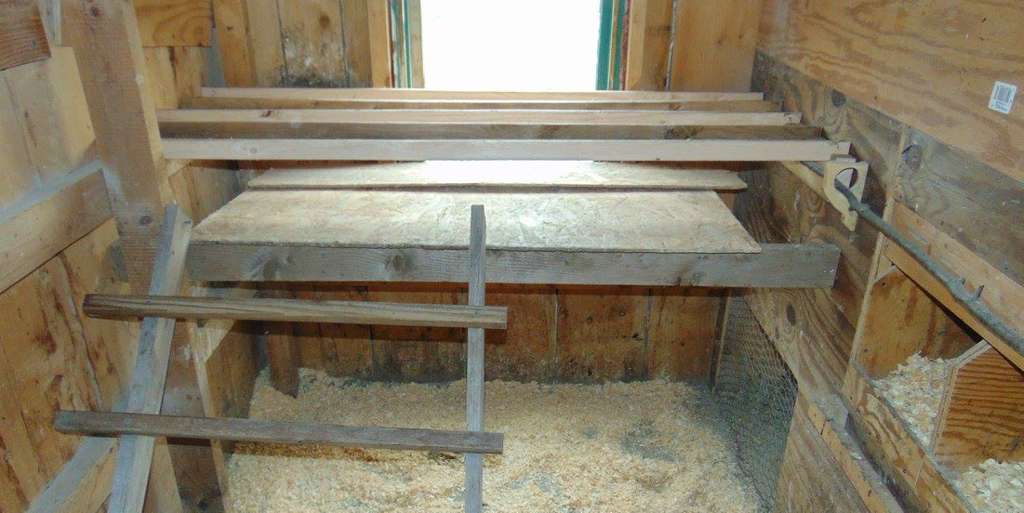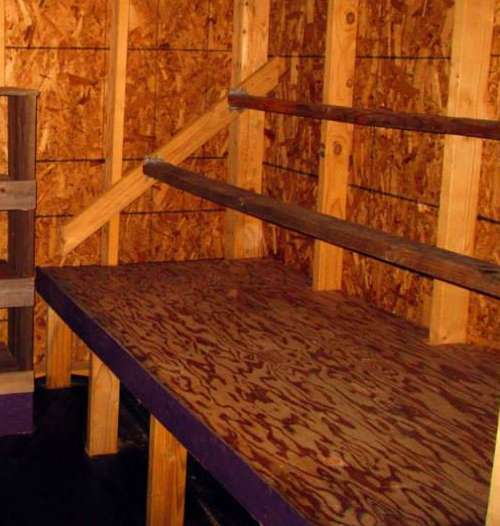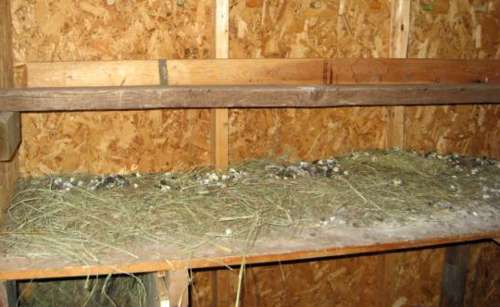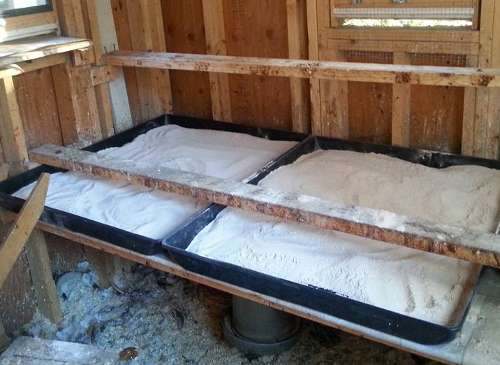Making droppings or poop boards work for you.

What is a droppings or poop board?
Poop boards or droppings boards are a rectangular sheet of wood (most commonly), plastic or metal that covers the floor under the roosts where your chickens sleep. Poop boards make cleaning simpler and and make chicken keeping that bit cheaper by saving money on bedding. Also known as a roosting drop board the idea behind this is to put a either a removable or easy to clean tray underneath the chickens’ roost in their coop.
A droppings board is a rectangular sheet of wood (most commonly), plastic or metal that covers the floor under the roosts where your chickens sleep. It can be removable, have a really thin layer of sand on it or just be scraped clean when you clean the coop.
Below: This Chicken coop has a well fitted Poop board covered in dry fine sand.

Some of the more complex designs are like a removable tray. Whichever you go for it should be easy to manage and reachable without any fuss.
You can cover the board in a plastic vinyl coating like you get for floors, it makes it even easier to clean.
I have installed several droppings boards in all my coops and would never go without one in the future, so it’s well worth considering for your coop.
Droppings or poop boards:
The reality is that in modern chicken keeping a droppings or poop board has come to mean a great many things but they all have the same basic function - to keep the chicken poo out of the floor covering and in one easy to clean place.
While the flock is in the coop, they spend the bulk of their time on the roost. By removing the waste they generate here, far less will be left in the coop proper. The droppings board itself is normally a removable tray, perhaps with a thin layer of sand or shavings on it. Alternatively, it can be a flat surface which can be scrapped.
Below: A plain but perfectly functional plain plywood droppings board.

The chickens shouldn’t want to get onto the droppings board, so it doesn’t need bedding material. The perches should always be around a foot above the board.
This method can be combined with any other approach to bedding, including the deep litter method. The droppings board decreases the amount of waste that gets into the bedding.
The benefits of droppings boards are:
- Making the coop easier to clean - the mess is all in one place.
- Save money because you don't need to change the litter on the floor as often.
- Cleaner feet and less poop smears on the eggs.
- Easier and quicker to dispose of.
- Reduces the amount of ammonia gas resulting in better air quality for you and the hens.
- You can see at a glance if anything is wrong with your flock just by looking.
- Reduces the moisture in the coop.
- Keeps the smell down.
Where does the droppings board go in the coop?
Underneath the perches that the chickens spend their nights on. Chickens poop all night and a board makes it easier to clean up in the morning. It needs to be securely fixed as the hens will wander over at the jump up and down to the perches.
Below: Plastic coated chipboard works just fine and is easy and cheap to work with.

There is a wide variety of droppings boards to inspire you with what is possible. A poop hammock is a related concept, but with a tarpaulin to catch the waste instead of a shelf.
Cleaning a droppings board:
I clean mine with a hand held scraper that is around 8 inches wide and collect it in a bucket. Most backyard flock keepers I know use a similar method. A little flick of dry sand over the board means the poo never sticks.
Scraping shelves can be done with a dedicated instrument, such as a spatula, sheet rock mudding tool, taping knife or a plastic knife. If you’re using sand, a kitty litter plastic scoop can be used to clean out the waste.
Then it's off to my compost heap for 12 months to rot down.
How wide should the poop boards be?
A Dropping board should extend at least eight and preferably 10 or 12 inches either side of the perch to catch all the mess. A thin layer of dry sand makes sure none of the poop sticks and can just be swept up in the mornings.
The dimensions of my droppings boards vary but the wider ones generally work better.
Why are poop or dropping boards useful to chicken keepers?
The droppings board will be more concentrated waste, which may be a good thing for your compost heap or however you’re disposing of it – you won’t have the increased volume and material from the bedding.
Reasons poop boards in coops are useful:
- Easier cleaning for the keeper.
- Save money on bedding.
- You can see potential problems with your chickens.
- You can see if any birds need treatment for worms or parasites.
- Reduces moisture in the coop.
Below: You can see at a glance if any of your chickens need attention or treatment.

Being able to see the chickens’ waste regularly lets you also see possible health issues – abnormal droppings are often an early indicator of trouble.
Additionally blood, worms and feathers will be easier to see on a droppings board, rather than mixed in with bedding. This can alert you to fighting, moulting or other issues.
Beyond this, not having to change the bedding as often saves money, decreases the number of flies, reduces ammonia exposure to the chickens, reduces moisture in the coop (which is important for winter) and leave you with a cleaner coop.
How to fit poop boards to a chicken coop:
Installation of the droppings board is a shelf that can be removed and dumped or scraped clean. If you decide to have sand or some other material to make it easier to clean, then it becomes more of a tray.
Below: Dropping boards do not need to be anything fancy. This one has been retrofit with sand trays.

How you install it will be determined by your coop design and how much work you want to have to do to keep it clean. The board should be wide enough to catch droppings from whatever position the chickens are in.
Some droppings board setups have wire to prevent chickens from walking in their waste and to prevent eggs from being laid in it. Others have found that cleaning up the wire is more work then it’s worth.
Chickens naturally like to roost on an elevated perch, so raising your roost to put a droppings board underneath it should make the roost more attractive to the chickens if anything. Hens will fight over the top roost, so it’s suggested to keep the entire roost at the same level.
How to make a droppings board for your coop:
Cut your choice of sheet material to size and fix below the roosts.
Below: This one has been covered with vinyl flooring to make cleaning really easy.

It is easiest to and is fit them when the initial build happens but they can be added later.
What is the best covering for poop boards:
It makes very little difference. Whatever is easy, cheap to get hold of and store. I have been using a little sprinkling of dry builders sand every day for at least a decade.
A piece of plywood covered in vinyl floor will last the lifetime of the coop.
